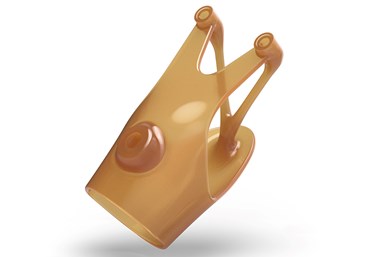3D Systems’ Accura AMX Resin Withstands Harsh Thermal Environments
Formnext 2023: The resin material is well suited for the testing of high-temperature components in applications such as HVAC, consumer appliances, motor enclosures, fixtures, mounts, stators, molding/tooling and more.
3D Systems’ Accura AMX High Temp 300C is an unfilled ultrahigh-temperature SLA resin that does not require a post thermal cure and is the engineered to meet the demands of applications requiring a HDT up to 300°C. Photo Credit: 3D Systems
3D Systems’ Accura AMX High-Temp 300C, is an ultrahigh-temperature stereolithography (SLA) resin that is engineered to meet the demands of applications requiring the highest levels of heat resistance. It is a print production-grade, highly thermal-resistant, translucent plastic for elevated temperature fluid or flow visualization.
The ultrahigh-temperature-resistant rigid plastic material is engineered to withstand the harshest thermal environments. The company says it is the industry’s most heat-resistant SLA material with a heat-deflection temperature (HDT) of over 300°C at low stress (at 0.455 MPa) that does not require a post thermal cure.
This material is well suited for the testing of high-temperature components in applications such as HVAC, consumer appliances, motor enclosures, fixtures, mounts, stators, molding/tooling and many others.
Applications include high-temperature components testing and general use parts, as well as low-pressure molding/tooling such as expanding foams and rubbers. It can also be used for functional prototype and production components for fixtures, mounts, housings, white goods and personal care products. It is also well suited for elevated-temperature fluid or gas flow visualization, and overmolding.
The resin also offers advantages such as a shortened production workflow and no requirement for a post thermal cure. It also provides excellent visualization for parts requiring evaluation of internal features and fluid flow performance; and chemical and auto fluid compatibility.
The resin also boasts isotropic properties. The SLA technology prints parts that are generally isotropic in mechanical properties, meaning the parts printed along either the XYZ axis will give similar results. Parts do not need to be oriented to get the highest mechanical properties, further improving the degree of freedom for part orientation for mechanical properties.
Related Content
-
Freeform Injection Molding Eases the Path to Medical Device Product Testing
A development and manufacturing service provider is using dissolvable molds to build injection molded silicone prototypes.
-
Additive Fusion Technology Optimizes Composite Structures for Demanding Applications
9T Labs continues to enhance the efficiency of its technology, which produces composite parts with intentionally oriented fibers.
-
Daimler, OMIC Evaluate Wire-Fed DED for Moldmaking
3D printing a core and cavity on machine from Gefertec, followed by machining, allowed for a complete mold tool to be produced in three days.

















